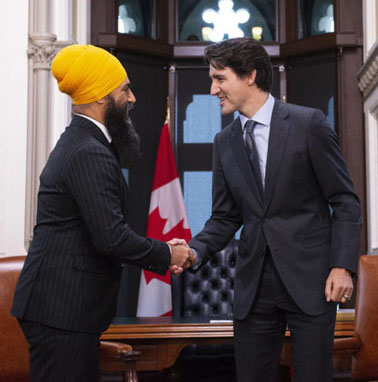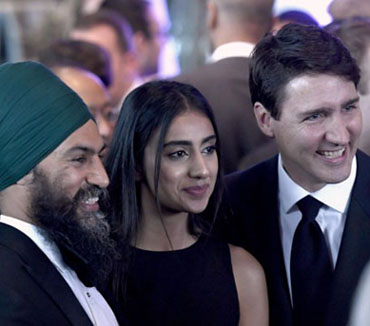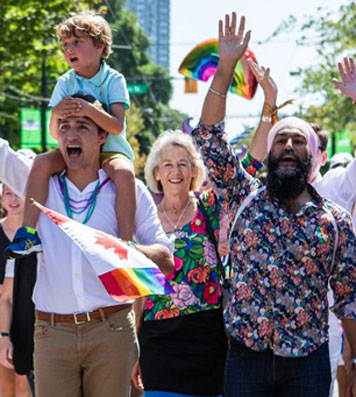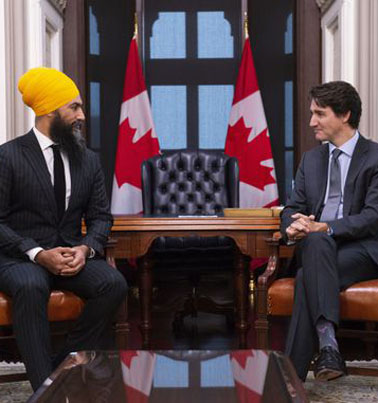Giving Canadians stable progressive government for the next three years in a stormy global village
Apr 15th, 2022 | By Counterweights Editors | Category: Ottawa Scene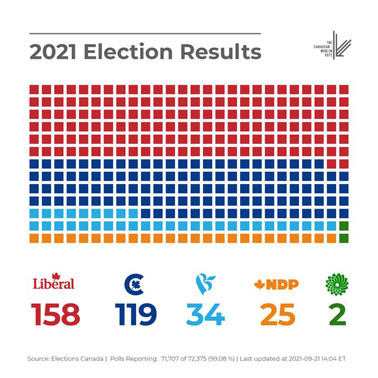
“LAMENT FOR A NATION”. COUNTERWEIGHTS EDITORS, GANATSEKWYAGON, ON, 15 APRIL 2022. According to pollster Nik Nanos the recent “Budget promises haven’t increased Liberal support” in Canadian federal politics. But this may not matter much.
The March 22 “Supply and Confidence Agreement” between the Justin Trudeau Liberals and Jagmeet Singh New Democrats likely enough means that there won’t be another federal election until October 20, 2025. There is plenty of time for the government’s (and the New Democrats’) polling numbers to improve!
Meanwhile, we counterweights editors have now had time to collectively pore over the text of the March 22 Agreement that appears on the Prime Minister of Canada website. And while we seem to agree that there are some serious moments of humour in this text, we feel pretty good about the Agreement and its potential impact on federal politics over the next three years.
According to rumour the essential nature of the new Delivering for Canadians Now, A Supply and Confidence Agreement was largely determined in conversations between PM Trudeau and NDP leader Singh. The actual detailed text of the ultimate written document, however, inevitably reads more like something finally negotiated by the two leaders’ staffs.
A quick overview
The general principles enunciated up front are straightforward enough : “The Liberal Party of Canada and Canada’s New Democratic Party have agreed to improve the way we approach politics over the next three years for the benefit of Canadians. The parties have identified key policy areas where there is a desire for a similar medium-term outcome.”
At the same time : “The parties will not always agree. The government will pursue elements of its agenda that the NDP may oppose and nothing in this agreement prevents either party from doing that.” Nonetheless : “The arrangement lasts until Parliament rises in June 2025, allowing four budgets to be presented by the government during this time.”
As a crucial part of the implementation of the Agreement : “Both parties agree to the minimum standing meetings: Leaders meeting at least once per quarter, Regular House Leader meetings, Regular Whip meetings, Monthly stock-take meetings by an oversight group” which “will consist of a small group of staff and politicians,” who “will discuss overall progress on key commitments and upcoming issues.”
The real fun begins when the document starts spelling out the “key policy areas where there is a desire for a similar medium-term outcome.” Broadly : “The Parties agree to prioritize the following actions, while continuing to work on other possible shared priorities through the oversight group … 1. A better healthcare system … 2. Making life more affordable for people … 3. Tackling the climate crisis and creating good paying jobs … 4. A better deal for workers … 5. Reconciliation … 6. A fairer tax system … 7. Making democracy work for people.”
Seven steps to heaven (CLICK HERE for musical accompaniment)
Under each of these seven headings more specific objectives are suggested. And it is here that Delivering for Canadians Now, A Supply and Confidence Agreement offers some serious moments of humour — or at least bemused states of wondering just what is really meant.
On “A better healthcare system” there are some almost impressive specific objectives on “Launching a new dental care program for low-income Canadians” and “Continuing progress towards a universal national pharmacare program.” But “Continuing progress” is of course not the same as having a program altogether up and running.
Under “Making life more affordable for people” there are again some quite specific objectives (“Extending the Rapid Housing Initiative for an additional year.”) Other objectives seem vague at best (“Moving forward on launching a Housing Accelerator Fund”). Others again are impossible to know what to make of (“Implementing a Homebuyer’s Bill of Rights and tackling the financialization of the housing market by the end of 2023”).
On “Tackling the climate crisis and creating good paying jobs” there are five objectives. Perhaps the most vague is the third : “Moving forward with Just Transition legislation, guided by the feedback we receive from workers, unions, Indigenous peoples, communities, and provinces and territories.”
There are only two objectives under “A better deal for workers.” The first sounds impressive : “Ensuring that the 10 days of paid sick leave for all federally regulated workers starts as soon as possible in 2022.” It becomes less impressive when you remember that only about 6% of the Canadian workforce falls under the jurisdiction of the federal government. (“The remaining 94% of Canadian workers fall under the legislation of the province or territory where they work.”)
Under “Reconciliation” there are four objectives, led by “Making a significant additional investment in Indigenous housing in 2022. It will be up to First Nations, Inuit and Métis communities to determine how housing investments are designed and delivered.”
On “A fairer tax system” the second of two objectives is “Implementing a publicly accessible beneficial ownership registry by the end of 2023”. But this apparently just speeds up by two years a commitment in the 2021 federal budget to “provide $2.1 million over two years to Innovation, Science and Economic Development Canada to build and implement a publicly accessible corporate beneficial ownership registry by 2025.”
Finally “Making democracy work for people” includes such to us foolish “ways to expand the ability for people to vote … as … An expanded ‘Election Day’ of three days of voting.” (Don’t we already have this with advance polls?) And then there are shades of the late great Jack Layton (or even Tom Mulcair) in the very last point here (and in the entire document) : “We commit to ensuring that Quebec’s number of seats in the House of Commons remains constant.”
Onwards and upwards
As amusing as all this may be (if you are in the right mood in any case) — and as already noted — we think both Jagmeet Singh and Justin Trudeau deserve a great deal of credit for doing something serious about the proposition that :
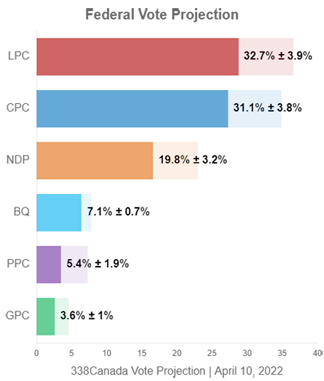
“Politics is supposed to be adversarial, but no one benefits when increasing polarization and parliamentary dysfunction stand in the way of delivering … results for Canadians.”
Nothing human is perfect, and in the end the Agreement may not work quite as planned.
But it has something of a predecessor in the Ontario Liberal-NDP Accord of 1985. It should give Canadians stable progressive government for the next three years — something that could prove almost unique in the contemporary global history of democracy.
As Chrystia Freeland’s new budget and its acceptance by Jagmeet Singh also show, this kind of government can be broadly fiscally responsible as well — like the Saskatchewan provincial governments of Tommy Douglas, 1944–1961.
(And however much all the right-wing conservative-owned mainstream media in Canada today may pretend to so vehemently disagree.)
